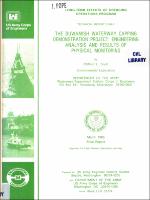Please use this identifier to cite or link to this item:
https://hdl.handle.net/11681/4864Full metadata record
| DC Field | Value | Language |
|---|---|---|
| dc.contributor | United States. Army. Corps of Engineers. Seattle District | - |
| dc.contributor | Long-Term Effects of Dredging Operations Program (U.S.) | - |
| dc.contributor.author | Truitt, Clifford L. | - |
| dc.date.accessioned | 2016-03-18T12:20:32Z | - |
| dc.date.available | 2016-03-18T12:20:32Z | - |
| dc.date.issued | 1986-03 | - |
| dc.identifier.uri | http://hdl.handle.net/11681/4864 | - |
| dc.description | Technical Report | - |
| dc.description | Abstract: The US Army Engineer District, Seattle, and the US Army Engineer Waterways Experiment Station have cooperated in a project in the Duwamish Waterway that successfully demonstrated the engineering aspects of subaqueous disposal and capping of contaminated dredged material. Approximately 1,100 cu yd of silty, clayey shoal material was removed by clamshell dredge, transported by barge, and bottom dumped through 70 ft of water into an existing depression. The site was then capped with successive loads of clean sandy cover. The technique has been termed contained aquatic disposal. This paper summarizes the initial fieldwork and presents results through the first (6-month) monitoring effort. The engineering effectiveness of the material placement and capping operation is examined using comparisons of replicate bathymetry and side scan sonar. The analysis indicates that the contaminated material exited the barge rapidly and descended to the bottom quickly as a well-defined, cohesive mass. Clean sand was applied successfully as a cap without displacing the softer contaminated material. A volumetric balance of materials is presented together with an error analysis for the calculated volumes based on the precision of the surveys used. Sufficient geotechnical information was also collected to allow for an approximate mass balance calculation. Sources for potential losses of material during the operation are examined. In particular, resuspension of sediment was measured during both the dredging and the disposal operations. A computer-aided method was developed to allow for rapid comparisons of suspended solids levels at different depths in the water column and at various sampling stations. | - |
| dc.publisher | Environmental Laboratory (U.S.) | - |
| dc.publisher | Engineer Research and Development Center (U.S.) | - |
| dc.relation | http://acwc.sdp.sirsi.net/client/en_US/search/asset/1004576 | - |
| dc.rights | Approved for public release; distribution is unlimited. | - |
| dc.source | This Digital Resource was created from scans of the Print Resource | - |
| dc.subject | Dredging | - |
| dc.subject | Dredged material | - |
| dc.subject | Dredging spoil | - |
| dc.subject | Contaminated sediments | - |
| dc.subject | Open-water disposal | - |
| dc.subject | Capped disposal | - |
| dc.subject | Water pollution | - |
| dc.subject | Water quality | - |
| dc.subject | Duwamish Waterway | - |
| dc.subject | Green River | - |
| dc.title | The Duwamish Waterway Capping Demonstration Project : engineering analysis and results of physical monitoring | - |
| dc.type | Report | en_US |
| Appears in Collections: | Technical Report | |
Files in This Item:
| File | Description | Size | Format | |
|---|---|---|---|---|
| Technical-Report-D-86-2.pdf | 19.83 MB | Adobe PDF |  View/Open |